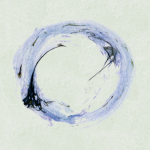While surfing the web tonight I came across a magnificently simple Zen image that transfixed my mind. Of course I’ve seen ensō before (Zen circles)–kind of hard to miss since I live in Japan–but tonight the image apparently worked its enlightening effect upon me. It took me by surprise.
According to Audrey Yoshiko Seo, author of Ensō: Zen Circles of Enlightenment, “Zen circles, ensō, are symbols of teaching, reality, enlightenment, and a myriad of things in between. Seemingly perfect in their continuity, balance, and sense of completeness, and yet often irregular in execution, ensō are at once the most fundamentally simple and the most complex shape. They seem to leave little room for variation, and yet in the hands of Zen masters, the varieties of personal expression are endless. Ensō evoke power, dynamism, charm, humor, drama, and stillness.”
From the Wikipedia entry on ensō:
Ensō (円相) is a Japanese word meaning “circle” and a concept strongly associated with Zen. Ensō is one of the most common subjects of Japanese calligraphy even though it is a symbol and not a character. It symbolizes the Absolute enlightenment, strength, elegance, the Universe, and the void; it can also symbolize the Japanese aesthetic itself. As an “expression of the moment” it is often considered a form of minimalist expressionist art.
In Zen Buddhist painting, ensō symbolizes a moment when the mind is free to simply let the body/spirit create. The brushed ink of the circle is usually done on silk or rice paper in one movement (but the great Bankei used two strokes sometimes) and there is no possibility of modification: it shows the expressive movement of the spirit at that time. Zen Buddhists “believe that the character of the artist is fully exposed in how she or he draws an ensō. Only a person who is mentally and spiritually complete can draw a true ensō. Some artists will practice drawing an ensō daily, as a kind of Spiritual Practice.”
Some artists paint ensō with an opening in the circle, while others complete the circle. For the former, the opening may express various ideas, for example that the ensō is not separate, but is part of something greater, or that imperfection is an essential and inherent aspect of existence (see also the idea of broken symmetry). The principle of controlling the balance of composition through asymmetry and irregularity is an important aspect of the Japanese aesthetic: Fukinsei (不均斉), the denial of perfection.




















We want your Help.
Hello dear, I’m From Sri Lanka. Srilanka is a Pure Buddhist country as you
know. The Buddhism is the only way to the peace proses. It’s only paramount
truth of the world. Ta day whole world is a military area. There is no peace in
the world.
Therefore we must bring lode Buddha”s peace massage to the world. Many
are waiting for lode Buddha’s peace massage. We should start a The Buddha’s
peace massage center to broadcast pure Buddhist massage to the world. I’m
waiting for your help.
Thank you,
ckumara32@gmail.com
ckumara32@yahoo.com
Hmm, I think I will look more into Enso. It’s so interesting. I consider the circle to be my favorite shape. It’s round, no edges, infinity, whole, or open. I like this concept and what it stands for, I will be looking it up a bit. Thanks!
Whatever makes this world more peaceful and and adds longevity to Our lives
Your blog is absolutely fantastic in which there are great information about yoga Training. Keep updating us with your blog 200 hour yoga teacher training in Rishikesh
Hey Brian,
I have seen many enso before, but never thought much about them. Japanese calligraphy can be a fascinating subject on it’s own. Calligraphy is something I always wanted to try. Your blog post inspired me to try it out and take a course.
Anyway, keep up the good work!